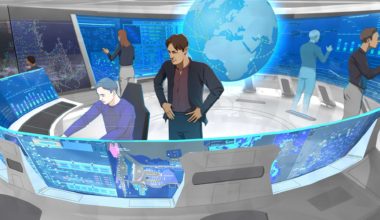Drones, robots, and self-driving vehicles seem to have become a weekly discussion topic for the logistics industry. With major players like Amazon, Google, DPD, UPS, and even convenience stores committing serious resources to the development of these solutions, there is a consensus that technology will play a crucial role in shaping the future of the transportation business. If we accept this argument, then we, as an industry, must begin to consider the way that this will impact delivery organizations around the globe so we can start to prepare our systems, processes, and people for what’s to come.
One can easily imagine a future not dissimilar from the current state, whereby a parcel is carried between major central hubs by automated trucks before being shuffled to a local depot for dispatch by a driverless van equipped with a team of delivery robots who will facilitate the final leg to the door or parcel drop. While this is certainly a step forward, it is far too simplistic. The real benefit of autonomous technologies lies not in their ability to fit within the current distribution model, but rather to profoundly reshape it! For the sake of this article, these technologies will be divided into aerial (drones), land (robots), and automotive (self-driving or driverless vehicles).
Table of Contents
Drones
There is much hype about drones providing a 10-30 minute aerial delivery service for lightweight consumables (generally up to 2.5 kg). While this will allow companies to offer a “convenience” service in the future, it is not where they will deliver lasting value. Their real worth lies in their ability to offer pick-up and drop-off at ad hoc locations. This will enable drones to provide new, dynamic services never before possible.
Imagine, for instance, that you’ve forgotten your office keys at home. In today’s world, this would mean you would have to return to collect them. For many commuters, this means an hour or more of lost time. In the future, you’ll use your smartphone to order and pay for a drone to pick up the keys from your home and deliver them to you as you arrive to work. The entire service will be individualized and managed without any rigid logistics frameworks.
Robots
Robots today already come in all shapes and sizes. First, their future versions will offer a very broad range of delivery options to logistics companies. From fleets of small and medium-sized robots delivering standard packages through to larger individual units capable of delivering heavy packages, the future will certainly include these sophisticated mixtures of soft- and hardware. Robots will not only assist their human counterparts, but like drones, will also open the door to innovative services.
Second, robots will also aid citizens logistically, so to speak. The flexibility to operate 24/7 in order to provide incredibly speedy service will reshape how consumers approach common household scenarios. In the future, when your child comes down with a fever late at night, you won’t be rugging them up, packing them into the car, and driving to the hospital. No, you will remotely consult with your general practitioner, who, if need be, will dispatch any required medicines or equipment via a robot from your preferred pharmacy. The entire process will likely take half an hour from start to finish – and anyone with children knows this is a dramatic improvement from today’s status quo. Robots will not only open new delivery options to end users, but empower a greater shift toward remote services.
Self-Driving Vehicles
Autonomous cars and trucks have been making headlines for decades; however, it is their recent history that is the most promising. In 2015, Daimler received a license to operate its autonomous truck in Nevada, US. Self-driving vehicles are already challenging the entrenched state of affairs and making their way into the market.

In the future, self-driving technologies will move from trucks into vans and eventually to cars. As this happens, more and more vehicles will transition to unmanned operations. This adds to the ability of logistics operators to run beyond the standard working hours. Autonomous vehicles will further extend the effective ranges of other technologies from their primary depots, which on their own are often limited. Logistics operators will gain greater flexibility to continuously respond to market conditions, e.g., with mini “pop-up depots.”

Once-in-a-Lifetime
In short, each of these technologies allows us to imagine, at least in some respects, a better tomorrow powered by innovation and outside-the-box thinking. On its own, each technology has the ability to reshape the way consumers interact with logistics operators. Collectively, they present a once-in-a-lifetime opportunity for operators to create truly innovative services that will reshape the consumer-commerce market relationship. When we look at how they could come together to redefine logistics as a whole, things get even more exciting!
End-to-End Automation
The technology required to automate logistics exists. Depending on which side of the Fourth Industrial Revolution you’re standing on, this is either exciting or just the opposite – it’s the first sound of war drums preceding doomsday. That said, while it’s more than likely that certain groups of interest will push back on the idea of autonomous technologies taking over traditionally manned roles – it will nevertheless happen, just as steam engines and the light bulb did.
Automation has already been underway at ports around the globe. Its adoption is spreading rapidly to other industries as well. The legalization of the technology will only continue as it improves. For example, the US government took a positive position on self-driving vehicles in late 2016, describing a future when autonomous vehicles will save time, money, and lives. To add fuel to the fire, the US entered 2018 with a continuing shortage of 100,000 qualified drivers, a shortage that shows no sign of resolution there and also in Europe. Self-driving vehicles are well positioned to fill this shortage, or, likewise, to make the trucker profession more attractive by paradoxically taking the strenuous driving hours, especially at night, out of the equation.
From there, automation will continue as newer robotic technologies continue to evolve, benefiting from increased real-world testing, advances in artificial intelligence (AI) and machine learning (ML), and positive end-customer feedback. This last point is crucial. For instance, robots delivering parcels are an unprecedented change in how consumers interact with parcel delivery. Remember, consumers can either accelerate or break the neck of technology adoption, so almost every parcel operator is looking more intently for consumer feedback data to improve future services. This is true both for parcel logistics and across the broader supply chain.
Dynamic Networks
As logistic operators services become more autonomous, so too will the broader logistics network that supports it. The future networks will be more dynamic and nimble than today’s. Supply and demand ebbs and flows. What’s new here is that autonomous technologies can be redeployed more easily than their traditional manned counterparts. This flexibility will provide operators with newfound abilities to transform their nowadays static networks into a dynamic, data-driven environment of the future.
Last-mile delivery optimization is already evolving to cater to increasing data that allows for optimized routes. As an extension, if we apply the system logic already available to manage portable assets to autonomous technologies, operators will have a system that can not only react to operational changes, but grow to predict them and proactively balance resource requirements in advance. This agile approach is already proven to decrease required asset pools while increasing service levels. Applied to autonomous technologies, it would have a significant impact on managing capital expenditure and improving customer service levels in a dynamic network.
Systems
Technology in general is an enabler of innovative ways of doing business. The systems of logistics operators will evolve in the future from a disparate network of interconnected facilities into a centralized ecosystem that isn’t physically tied to any single facility. Core system processes will be managed from a central location with remote presence at each individual facility.
By centralizing and interconnecting the physical and technological systems, operators will open the door to streamlined and higher quality decision-making as well as improved efficiency and increased flexibility. By taking as many factors as possible into consideration, planning and execution will improve. Decisions that adversely impact the broader ecosystem will be known in real time and their effects can be planned for, and in many cases mitigated, leading to an overall improvement in system efficiency. Finally, the dynamic networks of the future will require “light local infrastructure” to enable resilience in the network model. A dynamic model only works if the effort to remain such is minimal.
Processes
The processes of the future will need to be more dynamic, too. This is a counterintuitive point, as drones, robots, and self-driving cars are currently prone to failure in unpredictable situations. How-ever, as autonomous technologies continue to evolve, the range of processes that they are exposed to will as well. In no uncertain terms, the technology will become smarter and better able to respond to unforeseen circumstances on its own through the use of AI and ML technologies.

It is at this point that I make my case for more dynamic processes for the future. AI is on track to reach a point where it can make decisions on its own, within the parameters of acceptable operation, that lead to a positive outcome. The processes of the future will need to move from mostly rigid “if this, then that” models to ones focused on goals achieved through acceptable operational parameters.
People
Reading this article, it would be easy to believe that humans have no place in the future of logistics – but nothing could be further from the truth. The future will see a shift in the roles and responsibilities of humans; that’s a given. After all, robots are only good at doing what they are programmed for. However, how humans approach traditional roles will need to change. Also, new kinds of jobs will be created. Instead of truck drivers and dispatchers, we’re more likely to see technicians, analysts, and strategists. The society has the responsibility to facilitate this transition, which won’t happen cost-free, so that vulnerable groups won’t be left behind.
As drones, robots, and self-driving vehicles enable an ever-increasing customer-specific experience, the way we view and measure success will evolve. Dispatchers will move from managing the mundane to orchestrating a strategy that aims to achieve a new era of key performance indicators. This new indicator set will be increasingly customer-centric in a way that enhances individualized experiences and customer journeys.
It Has Already Begun
In this article, we’ve looked at what drones, robots, and self-driving technologies can achieve, what their collective impact might be on the industry that is constantly changing, and how the business of transport and logistics might have to evolve to better enable these changes to happen. One could easily dismiss this as overly optimistic or futuristic. But the simple fact of the matter is the journey has already begun.
Operators all over the world are embracing these technologies, relying on the promise of bringing about a future which, although digital, will also create a new, hopefully better reality. It is worth remembering that with pretty much any technological innovation, the first movers and early adopters get the upper hand in defining the customer experiences of tomorrow, against which all operators will be measured eventually.


